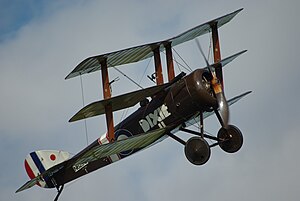| Sopwith Triplane | |
|---|---|
 Triplane reproduction G-BOCK at Old Warden, 2013 | |
| General information | |
| Type | Fighter |
| National origin | United Kingdom |
| Manufacturer | Sopwith Aviation Company |
| Designer | |
| Primary user | Royal Naval Air Service |
| Number built | 147[1][2] |
| History | |
| Introduction date | December 1916 |
| First flight | 28 May 1916 |
The Sopwith Triplane is a British single seat fighter aircraft designed and manufactured by the Sopwith Aviation Company during the First World War. It has the distinction of being the first military triplane to see operational service.
The Triplane was developed by the firm's experimental department as a private venture, the project was headed by the designer Herbert Smith. Aside from its obvious difference in wing configuration, the aircraft shared many similarities with the company's successful biplane fighter, the Sopwith Pup. The prototype Triplane performed its maiden flight on 28 May 1916 and was dispatched to the French theatre two months later, where it garnered high praise for its exceptional rate of climb and high manoeuvrability. During late 1916, quantity production of the type commenced in response to orders received from the Admiralty. During early 1917, production examples of the Triplane arrived with Royal Naval Air Service squadrons.
The Triplane rapidly proved to be capable of outstanding agility, and thus was quickly deemed to be a success amongst those squadrons that flew it. Praise for the type extended to opposing pilots; Imperial Germany extensively studied the Triplane via captured examples and produced numerous tri-winged aircraft shortly thereafter. Nevertheless, the Triplane was built in comparatively small numbers to that of the more conventional Sopwith Pup. It had been decided to withdraw the Triplane from active service as increasing numbers of the Sopwith Camel arrived in the latter half of 1917. Surviving Triplanes continued to serve as operational trainers and experimental aircraft until months following the end of the conflict.